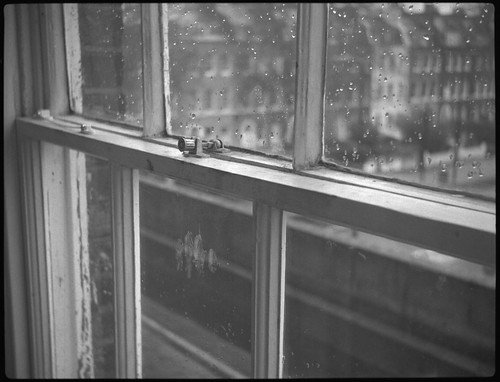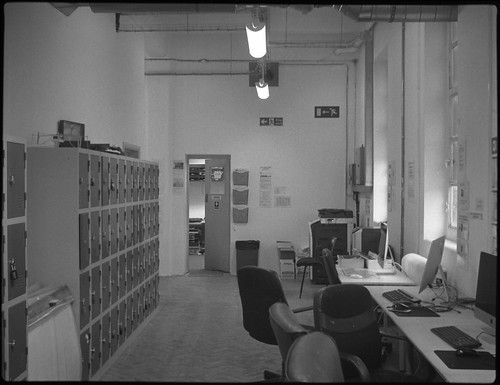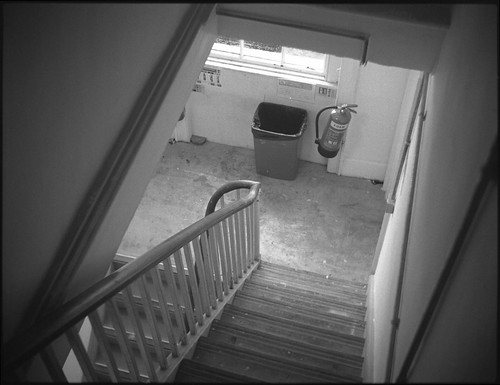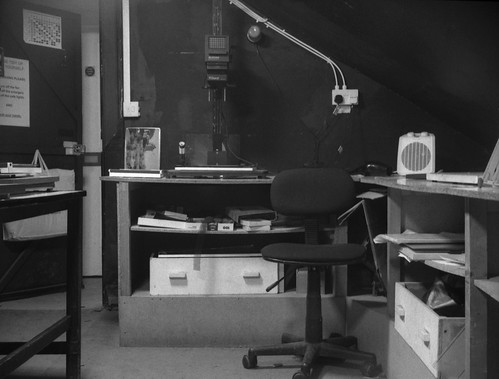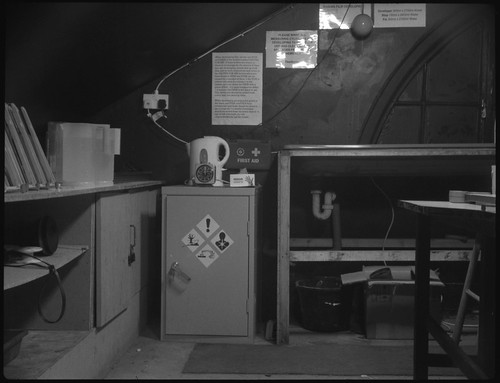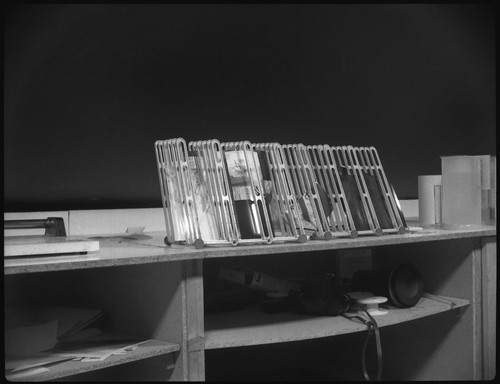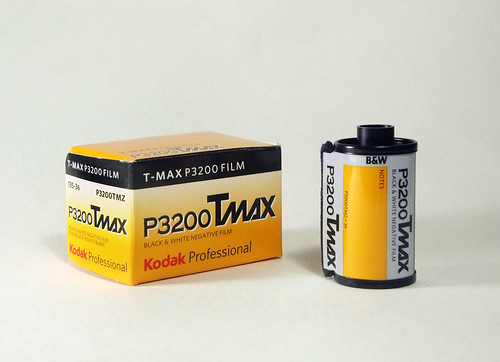 |
| Kodak T-Max P3200 |
KODAK PROFESSIONAL T-MAX P3200 Black & White
Negative Film ⁄ 3200TMZ is a multi-speed
continuous-tone panchromatic black-and-white negative
film that combines high to ultra-high film speeds with finer
grain than that of other fast black-and-white films. It is
especially useful for very fast action; for dimly lighted
scenes where you can’t use flash; for subjects that require
good depth of field combined with fast shutter speeds; and
for handholding telephoto lenses for fast action or in dim
light. It is an excellent choice for nighttime photography.
T-Max P3200 data sheet
When I wrote my
previous post on
Kodak T-Max P3200 it had been discontinued for two years; with Kodak's rationalisation of their product lines at the time, I would not have predicted that the film would be
reintroduced just fours years later. Many online commentators are more excited by the reappearance of
Ektachrome, and perhaps understandably so; some photographers - myself included - would like to see
Plus-X return, but it could be argued that as Kodak do already have a medium speed black and white emulsion in T-Max 100, that being able to compete with Ilford's
Delta 3200 at the upper end of the speed table makes sense in terms of a market strategy. T-Max P3200 was first introduced in 1988, a whole ten years before Delta 3200; like Ilford's film it is essentially a fast film designed to be push-processed. The data sheet states that T-Max P3200's
nominal speed is EI 1000 in T-Max developers, or EI 800 in other developers - some commentators make much of this fact in online pieces about the film, but Kodak are open about what the film is: the P before 3200 in the name denotes that the film is designed for
push processing. Of course, the film cartridge is actually DX-coded to 3200, so, in cameras with DX-coding it will be exposed at EI 3200 unless manually set. No doubt, without instructions to the contrary, labs would also develop it as if shot at 3200. Like Delta 3200, Kodak T-Max P3200 is essentially a versatile high speed film, with excellent latitude and manageable contrast - two factors that important to the ability to successfully push a film.
When I last wrote about T-Max P3200, I hadn't made any evaluative tests with it: I had used a couple of rolls of out-of-date film for that post, as well as reflecting of first using the film in the mid-1990s, before Ilford also entered the market for ultra-fast films with Delta 3200. With a new batch of the film, I thought it was worth revisiting T-Max P3200 and I began, as with testing most new films, by making a latitude test.
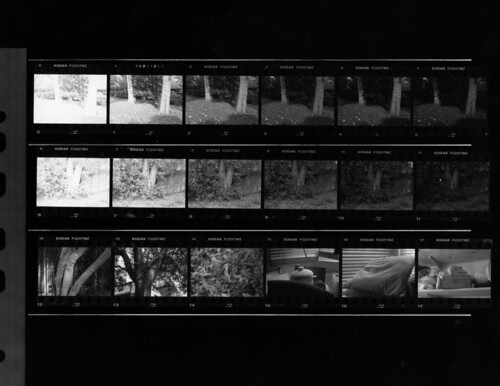 |
| Kodak T-Max P3200 latitude test contact sheet |
The results from this first test appeared to demonstrate that T-Max P3200 has excellent latitude: although developed at the recommended time for being exposed at EI 3200, almost all frames yielded a usable image. Shadow detail was thin at 6400 and clearly lacking at 12800, but this is dependent on the subject contrast: this was less of a problem in images with a narrower brightness range (when choosing the two different shots for comparison at different exposure indexes, I deliberately to framed one shot with a sunlit foreground in the frame and deep shadows; for the other set of six frames, the subject was all in open shade, and therefore less extremes of light and dark). Those shots at lower exposure indexes performed very well indeed, perhaps unsurprising given T-Max P3200's true speed, but even when rated at 400, there was no real evidence of highlights blocking out. For a film with great latitude, contrast was not as flat as one might expect (compare, for example,
Ilford XP2 Super, while a very different film - for all the reasons described on my post - it has very low contrast which must in part contribute to its wide latitude). The two images below, which were scanned fairly 'straight', without much in the way of any adjustments, demonstrate a difference of 5-stops exposure, developed together.
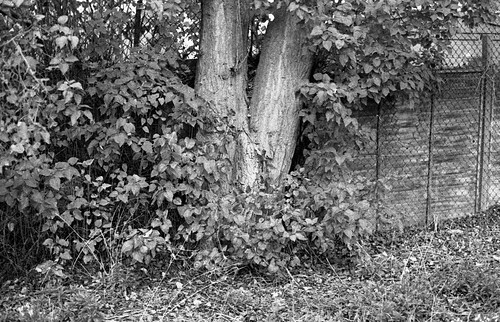 |
| Kodak T-Max P3200, rated 400 |
 |
| Kodak T-Max P3200, rated 12,800 |
Kodak's data sheet for the film list a number of Kodak's own proprietary developers - none of which I habitually use. For the latitude test, I used Fomadon R09 diluted 1+25, for 8 minutes at 20ºC, derived from the
Massive Dev Chart; most listings are annotated that the data is taken from a previous version of the film, but there is no reason to suspect the new iteration of T-Max P3200 is any different. With R09, the appearance of the film's grain is quite pronounced, as one would expect; initially I suspected that I might not like the combination of T-Max P3200 and R09, but, despite it appearing obtrusive in some images, generally the combination did not seem too objectionable. Of course, a fuller review of the film would include testing some of Kodak's recommended proprietary developers; previously I had used T-Max P3200 with ID11, Ilford's equivalent of Kodak's D76: the grain here does appear smoother than with R09. The data sheet also warns that T-Max P3200 will exhaust fixer more rapidly than other films, this is presumably due to the emulsion density of the film, and is worth bearing in mind when processing.
 |
| Kiev-4 with Kodak T-Max P3200, developed in Fomadon R09 |
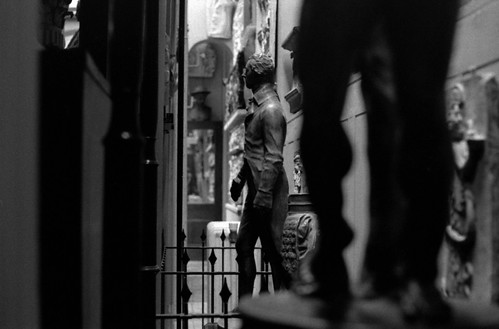 |
| Praktica BCA with Kodak T-Max P3200, developed in ID11 |
One note on Kodak's data sheet in the section on spectral sensitivity caught my eye:
The blue sensitivity of KODAK PROFESSIONAL
T-MAX Films is slightly less than that of other KODAK
panchromatic black-and-white films. This enables the
response of this film to be closer to the response of the
human eye. Therefore, blues may be recorded as slightly
darker tones with these films—a more natural rendition.
Having hardly ever used Kodak's T-Max films before, this was new to me. Some shots with Kodak T-Max P3200 in daylight with blue skies do look as though these were made with a yellow filter, as one might expect for most black and white films, however, Kodak T-Max P3200 is possibly the one film that might not feel like a natural choice to use for daylight photography in sunny conditions. The image below was shot on a bright autumn morning, and although the contrast between the brightness of the concrete and the sky enhances the effect, I was still impressed by the darkness of the blue sky without use of a filter.
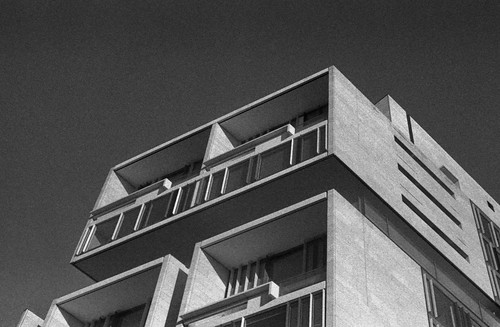 |
| Kiev-4 with Kodak T-Max P3200 at EI 3200, developed in Fomadon RO9 |
Instead of bright sunny days, Kodak T-Max P3200 is really a film designed for more difficult lighting conditions. At a rating of EI 3200, the film is usually sensitive enough for hand-held night photographs under street lights - with relatively fast lenses - or dimly-lit interiors (it's always seemed to be a popular choice for gig photography, for example). These situations often provide brightly lit but highly localised areas surrounded by deep shadows, conditions less than ideal when pushing slower films, as pushing increases contrast. When it was discontinued, Kodak recommended using T-Max 400, push-processed, instead, but did admit that "The exception [to replacing T-Max P3200 with T-Max 400] would be extremely low light situations where P3200 might be able to pull out some shadow detail that would otherwise be lost". As the data sheet specifies, with T-Max P3200 "...you will obtain better shadow detail and highlight
separation when you expose it at EI 3200 or 6400 than
you can obtain with 400-speed films pushed by 3 stops."
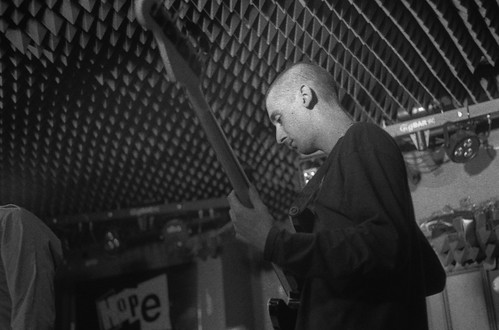 |
| Kiev-4 with Kodak T-Max P3200 at EI 3200, developed in Fomadon R09 |
Kodak's data sheet includes developing times for rating the film up to EI 25,000; when making my tests, as well as shooting it at the 'box speed' of 3200, I wanted to test the film one stop either side of this, rating it at both 1600 and 6400. Judging from the latitude test, one could probably rate frames at both 1600 and 3200 on the same roll and develop this for the times for EI 3200 without any real drawback in quality: it's interesting to see on Kodak's data sheet how close the development times are for each stop in exposure, with some developers giving less than a minute difference between some stops. Quite possibly, most photographers developing the film themselves might have a margin of error in time (and temperature) that could encompass that amount of development fairly easily. Exposed and developed for EI 6400 does allow hand held shots in quite dark situations, which, when the film was new, must have seemed all the more impressive than perhaps it does today; I didn't find myself wishing for an extra stop or two, but further tests in the right developers at EI 12,800 and 25,000 possibly would not be as revelatory as they might promise.
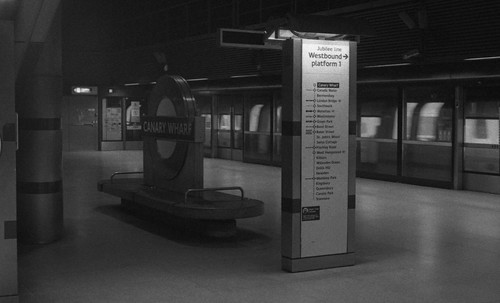 |
| Canon A-1 with Kodak T-Max P3200 at EI 6400, developed in Ilfotec LC29 |
Although the name of the film rather suggests naturally exposing it at an exposure index of 3200, Kodak's data sheet has the telling sentence, "Because of its great latitude, you can expose this film at
EI 1600 and yield negatives of high quality. There will be no
change in the grain of the final print, but there may be a
slight loss of shadow detail [over rating it at EI 800]." Rating the film at 1600 would appear to be the best balance of speed against grain and retention of shadow detail. For the test at EI 1600, I wanted to use R09 at a dilution of 1+50, rather than 1+25, having seen a number of examples online where this looked as though the grain may appear a little less pronounced.
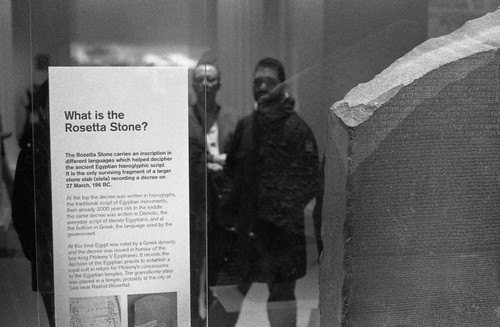 |
| Canon A-1 with Kodak T-Max P3200 at EI 1600, developed in Fomadon R09 |
I shot much of the roll rated EI 1600 in the sort of conditions in which I would have first used the film two decades ago: in a museum, with low lighting, but with relatively bright, localised sources of light. The rest of this roll was shot in a variety of lighting conditions, and, overall, proabably gave the best results. A higher dilution of R09 may have helped the sharpness of the negatives; further tests at perhaps 1+75 and 1+100 may be instructive in this regard. Of course, I haven't made any tests with film developers recommended by Kodak for T-Max P3200, but rather I've tested those that I would habitually use instead. I also haven't made any direct comparisons with Ilford Delta 3200, as
others have online (these look to show that T-Max P3200 has finer grain than Ilford's film): however, I've found this not to be exactly the case in my experience. Without making side-by-side comparisons (and, ideally, making darkroom prints of both), but looking at shots I've taken with Delta 3200 in 35mm, these may not have as fine a grain as T-Max P3200, but, to me, the grain of Delta 3200 appears
softer, with T-Max P3200 harder, sharper perhaps, but
perceptually more 'grainy' as a result.
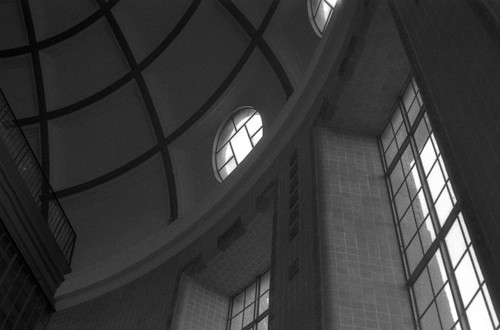 |
| Kodak Retina IIa with Ilford Delta 3200, developed in R09 One Shot |
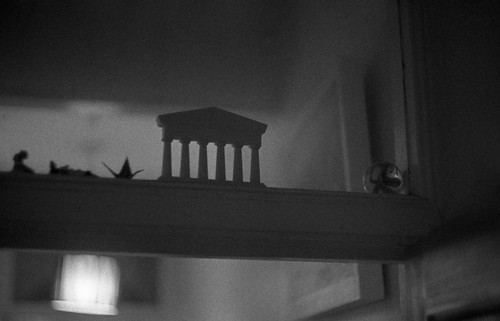 |
| Kiev-4 with Kodak T-Max P3200, developed in Fomadon R09 |
For me, Ilford Delta 3200 has long been my ultra-fast film of choice, partly due to having been always available throughout most of my years of taking photographs, appearing on the market relatively soon after first I began developing my own negatives; that it is also produced in medium format gives it the edge over T-Max P3200. However, the return of Kodak T-Max P3200 is most welcome in what now appears a more
volatile film market: some years ago, the variety of different films available was clearly shrinking, and T-Max P3200's original discontinuation was part of that - since then, even with other favoured films disappearing, there has been something of a small resurgence in the
range of film currently on the market, a situation to which a company as dominant as Kodak once was has been slow to react.
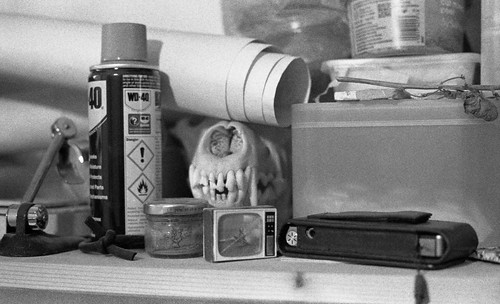 |
| Canon A-1 with Kodak T-Max P3200 at EI 1600, developed in Fomadon R09 |
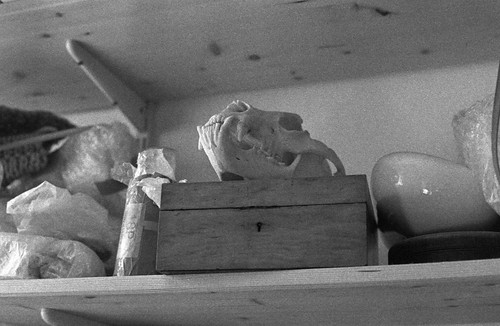 |
| Canon A-1 with Kodak T-Max P3200 at EI 3200, developed in Fomadon R09 |
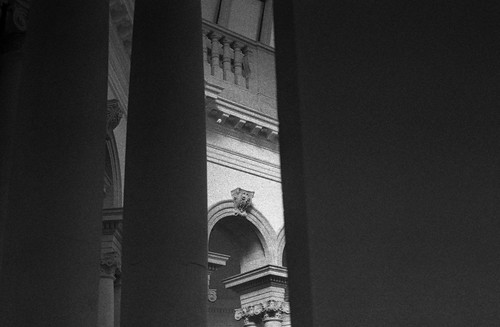 |
| Kiev-4 with Kodak T-Max P3200 at EI 3200, developed in Fomadon R09 |
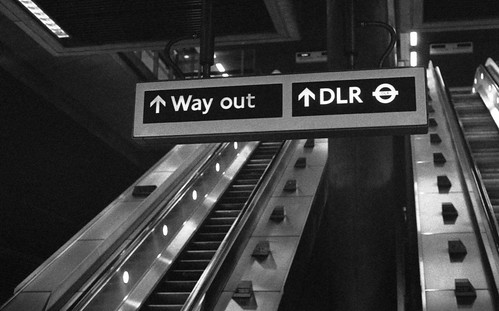 |
| Canon A-1 with Kodak T-Max P3200 at EI 6400, developed in Ilfotec LC29 |
Sources/further reading
Kodak T-Max P3200 data sheet (PDF file)
T-Max P3200 on the Casual Photophile
Richardphotolab.com all-about-Kodak's-T-Max-P3200-film
Kodak T-Max-P3200 review on Parallax Photographic
















